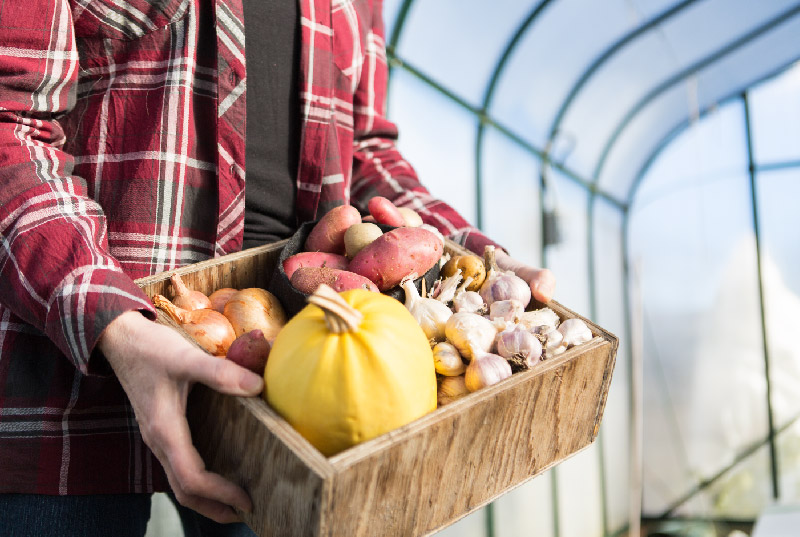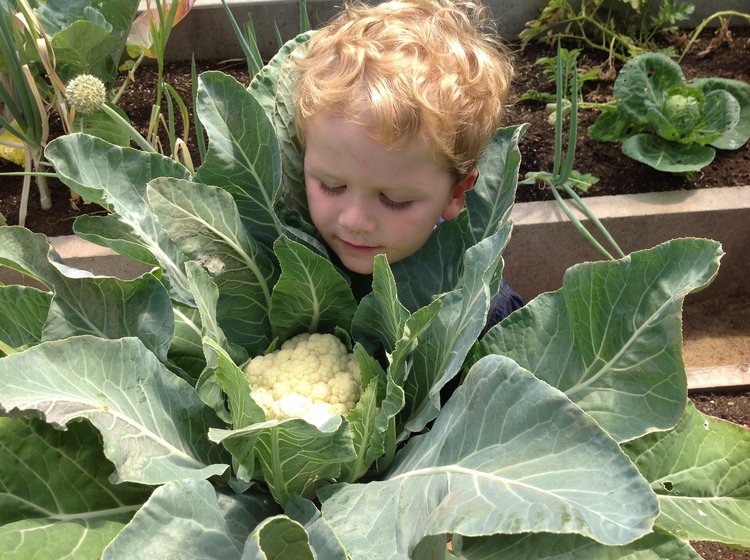
I help gardeners grow
& beginners blossom.
No seed left behind,
no soil unturned.
Together we can have lots of fun growing
great gardens using simple practical tips.
- Featured in -





Start saving & storing your garden seeds for a more more sustainable future
SIGN UP to get the FREE Seed packet PDF
X CLOSE

CAUL-AMITY IN THE GARDEN. BIG BUST WITH CAULIFLOWER
“It’s too heavy grandma” 4 year old grandson Rupert complained when asked to hold my cauliflower for a photo-op last year. I didn’t have the same problem this year, that’s for sure.
I have been gardening and writing about gardening for thirty years so I was basically bragging about growing the biggest and best cauliflower crop ever. Until I flunked out.
After the crazy price of cauliflower at stores last winter I resolved to grow even more cauliflower than ever before in 2016. But my lofty cauliflower goal didn’t just falter – it imploded. Everything looked so good, until it died or I deliberately killed it.
And in really bad news, my cauliflower crop took my tomatoes down with it.
Here is how I grow beautiful cauliflower. I seed it indoors in February, transplant it into the greenhouse in March and harvest large luscious heads in June.
Meanwhile I sprout more seeds indoors in April, plant them outside in May and harvest cauliflowers outdoors in August or September. A crop takes four months all in.
Except this year I messed up and planted the wrong cauliflower.
I must have ordered Galleon cauliflower online by mistake because it says right on the package it is ideal for planting in late summer and harvesting in winter. Maybe I’m dyslexic but I started it the other way around: in winter for a summer harvest.
I should have started the fast growing ‘Snow Crown’ seeds I ordered, but for some reason I left those in the package.
And at first I didn’t realize I had planted the wrong seed.
- My Second Mistake: I started my Tomatoes earlier than usual and planted them beside my cauliflower
I wasn’t taking an exciting vacation in February so I decided to seed my tomatoes extra early and plunk them in my greenhouse right beside my cauliflowers a full month ahead of schedule.
Remember I thought I was going to pull my mature cauliflowers in June, so why not get a head start on the tomatoes too?
“In an experimental planting, tomatoes near cabbages kept the white cabbage butterfly away” according to the 1966 book Companion Plants and How to Use Them, a book based on field work originally done in 1943. “Sounds good”, I thought, “Maybe the tomatoes will help out their cauliflower friends?”. But of course it was just guff – no basis for the Companion planting info and in fact I found out cauliflower doesn’t protect tomatoes either. It kills them.
I have grown tomatoes and cauliflowers together in past but the plants only overlapped in the greenhouse ground for six weeks before the cauliflower produced huge heads, they were harvested, and the greens were quickly whisked off to the compost.
My tomatoes always seemed poor initially but I wrote that off as the effect of cool soil in early spring. Anyways the tomatoes always improved by early July. (Lightbulb! They improved right after I removed my cauliflowers.)
But this year, at the end of June I was panicking when I saw how big the cauliflower plants were getting with no sign of flowering. The plants were so robust I expected a huge yield so I decided to give them one more month.
So to be perfectly clear I started the wrong cauliflower and all my various tomatoes at the same time and planted them in my greenhouse at the same time. I estimated the cauliflowers would get about 60 -75 cm across and I thought the tomatoes would shoot up well above the cauliflowers.
When my cauliflowers grew over a meter across my tomatoes, trapped in between the massive plants, started flagging. “Only a few more weeks,” I thought, and they will bloom. “Then I will take the cauliflowers out and the tomatoes will improve”.
And so, as a curious gardener, I checked my records and discovered I had started the late cauliflower Galleon in February and the early-producing seeds were still in the packets ready to be planted. Oops.
It was late July. My cauliflowers were taking up even more space and they looked amazing with rigid, rugged pest-free leaves. I was proud of their excellent growth because I had mineralized my soil following Steve Solomon’s instructions in his book, “the intelligent gardener.” The leaves were blue and sturdy and glossy and pest free as promised. They looked perfect. But they still weren’t blooming.
And meanwhile, my tomatoes were dying. So, in desperation, I started selectively pulling out individual cauliflowers to make space for the tomatoes and I started adding commercial tomato fertilizer. By then, the plants had been in the ground together for five months with no sign of cauliflowers.
A week after fertilizing, the tomato plants started growing and blooming. At the same time, the cauliflowers started getting buggy. The sudden imbalance in nutrients triggered by the commercial fertilizer had put out the siren call to pests.
Like putting up an “Open For Dinner” sign for bugs, my cauliflower plants suddenly drew in hordes of white butterflies. And they still weren’t blooming.
- Mistake Number 5: I didn’t Check References
According to Soil Scientist Elaine Ingham’s Soil Food Web CD that I listened to and made notes from ten years ago, broccoli and cauliflower kill off mycorrhizal fungi in soil. Part of this is because cabbage doesn’t need fungal mycorrhizae to thrive so they kill it off to torture competing plants that need the fungus to mine the minerals on their behalf.
Tomatoes normally trade the energy they collect from the sun for minerals gathered by the mycorrhizae. It’s a swap meet where plants trade fungi: sugary sap for minerals. My tomato plants were starving because the cauliflower had killed their fungal friends. Last week, while reading through my old notebooks, I saw what was happening.
When mycorrhizae are absent, plants have to be force-fed. Like some kind of fad-food diet drink, plants need liquid fertilizer if they don’t have a healthy population of bacteria and mycorrhizae to bring home the bacon. But I was killing my mycorrhizae with my cauliflowers.Meanwhile, I was shifting my soil mineral balance from perfect to out of balance with the fertilizer and suddenly my cauliflower plants were weak and were attracting pests.
And then I received Robert Kourik’s new book, “Understanding Roots” (2015, http://www.robertkourik.com) – and on the last few pages Kourik says that cauliflowers and all other cabbage relatives are allelopathic to other garden vegetables. If you haven’t heard this word it means toxic – poisonous. The cauliflowers were not only cutting off the food supply to my tomatoes by killing the root fungus, they were actively declaring war and killing the tomatoes with chemicals exuded from their roots.
- In Summary: Don’t plant Cabbage or Cauliflower or Broccoli near tomatoes!
So I am a failed gardener. Even with specially prepared, compost enriched, mineralized soil and a cozy greenhouse, I did not grow cauliflowers this summer. And my tomatoes almost died while I was trying to grow Cauliflowers.
I finally gave up and pulled out the cauliflowers in late August after six months of nurturing them.
In my greenhouse I removed the worst of my tomato plants and seeded buckwheat in the now mostly empty greenhouse soil. I’ve left town for a few days to get over the embarrassment and I am sitting at a writing retreat where I should be starting a new book but instead I am writing this blog post.
Meanwhile I still have high hopes for my outdoor cauliflower. I not only planted Galleon outside, I started my early varieties in July and planted those outside too.
I am counting on a warm fall with nice gentle rains to entice sturdy cauliflower heads. In other words. like any gardener, I am being optimistic.(Update: by late October I had a few small heads of cauliflower outside but nothing of the award winning size of previous years.)
I can definitely and for sure say the advice from the Companion Planting book is crazy nonsense. It is Guff.
And if you are thinking of growing cabbages, broccoli, Brussels sprouts, or Kale in your garden next year, read the seed packet labels before you plant, give them a wide berth, and keep your tomatoes out of their way.
Meanwhile I am going back to buying seed at the garden center where I can read and consider all the options before I rashly hit the “buy now” button.
I spent six months growing fabulous plants in my limited greenhouse space for zero return. Luckily so many other things turned out so wonderfully I can’t complain. Anyone for a zucchini or radish or potato? I’ve got tons. Come on over.
What Would Donna Do?
Get my growing and gardening tips and pointers throughout the season.
























0 Comments